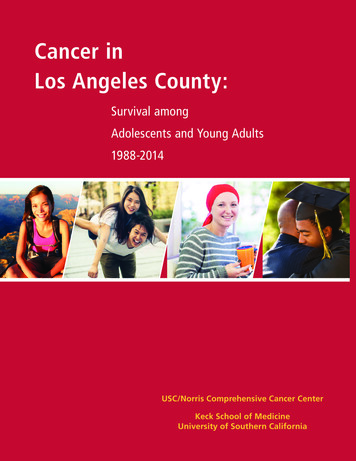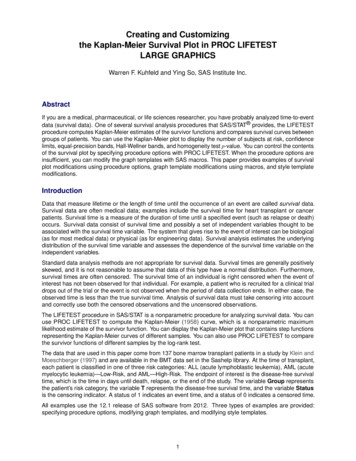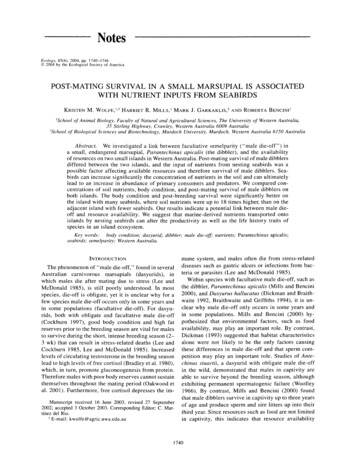
Transcription
NotesEcology, 85(6), 2004, pp. 1740-1746C 2004 by the Ecological Society of AmericaPOST-MATING SURVIVAL IN A SMALL MARSUPIAL IS ASSOCIATEDWITH NUTRIENT INPUTS FROM SEABIRDSKRISTEN M. WOLFE,'13 HARRIET R. MILLS,'MARK J. GARKAKLIS,2AND ROBERTA BENCINI'tSchool of Animal Biology, Faculty of Natural and Agricultural Sciences, The University of Western Australia,35 Stirling Highway, Crawley, Western Australia 6009 Australia2School of Biological Sciences and Biotechnology, Murdoch University, Murdoch, Western Australia 6150 AustraliaAbstract. We investigated a link between facultative semelparity ("male die-off") ina small, endangered marsupial, Parantechinus apicalis (the dibbler), and the availabilityof resources on two small islands in Western Australia. Post-mating survival of male dibblersdiffered between the two islands, and the input of nutrients from nesting seabirds was apossible factor affecting available resources and therefore survival of male dibblers. Seabirds can increase significantly the concentration of nutrients in the soil and can ultimatelylead to an increase in abundance of primary consumers and predators. We compared concentrations of soil nutrients, body condition, and post-mating survival of male dibblers onboth islands. The body condition and post-breeding survival were significantly better onthe island with many seabirds, where soil nutrients were up to 18 times higher, than on theadjacent island with fewer seabirds. Our results indicate a potential link between male dieoff and resource availability. We suggest that marine-derived nutrients transported ontoislands by nesting seabirds can alter the productivity as well as the life history traits ofspecies in an island ecosystem.Key words: body condition; dasyurid; dibbler; male die-off; nutrients; Parantechinus apicalis;seabirds; semelparity; Western Australia.mune system, and males often die from stress-relateddiseases such as gastric ulcers or infections from bacteria or parasites (Lee and McDonald 1985).Within species with facultative male die-off, such asthe dibbler, Parantechinus apicalis (Mills and Bencini2000), and Dasyurus hallucatus (Dickman and Braithwaite 1992, Braithwaite and Griffiths 1994), it is unclear why male die-off only occurs in some years andin some populations. Mills and Bencini (2000) hypothesized that environmental factors, such as foodavailability, may play an important role. By contrast,Dickman (1993) suggested that habitat characteristicsalone were not likely to be the only factors causingthese differences in male die-off and that sperm competition may play an important role. Studies of Antechinus stuartii, a dasyurid with obligate male die-offin the wild, demonstrated that males in captivity areable to survive beyond the breeding season, althoughexhibiting permanent spermatogenic failure (Woolley1966). By contrast, Mills and Bencini (2000) foundthat male dibblers survive in captivity up to three yearsManuscript received 16 June 2003; revised 27 September ofage and produce sperm and sire litters up into theirEditor:C. Mar2002; accepted3 October2003. Correspondingthirdyear. Since resources such as food are not limitedtfnez del Rio.3E-mail: kwolfe@agric.uwa.edu.auin captivity, this indicates that resource availabilityINTRODUCTIONThe phenomenon of "male die-off," found in severalAustralian carnivorous marsupials (dasyurids), inwhich males die after mating due to stress (Lee andMcDonald 1985), is still poorly understood. In mostspecies, die-off is obligate, yet it is unclear why for afew species male die-off occurs only in some years andin some populations (facultative die-off). For dasyurids, both with obligate and facultative male die-off(Cockburn 1997), good body condition and high fatreserves prior to the breeding season are vital for malesto survive during the short, intense breeding season (23 wk) that can result in stress-related deaths (Lee andCockburn 1985, Lee and McDonald 1985). Increasedlevels of circulating testosterone in the breeding seasonlead to high levels of free cortisol (Bradley et al. 1980),which, in turn, promote gluconeogenesis from protein.Therefore males with poor body reserves cannot sustainthemselves throughout the mating period (Oakwood etal. 2001). Furthermore, free cortisol depresses the im-1740
June2004NOTES1741may play an important role in male survival in captiv- nated by three species, Nitraria billardierei, Atriplexcinerea, and Rhagodia baccata. Human access is reity.Extensive research on seabird colonies around the stricted as they are Class A Nature Reserves (Conserworld has shown that breeding seabirds have a signif- vation and Land Management Act 1984), and there areno large terrestrial predators; however both islands areicant effect on the productivity of island ecosystems.Seabirds can increase greatly the concentration of nu- subject to aerial predators (raptor species). As well astrients in the soil (Gillham 1960, Ryan and Watkins supporting populations of dibblers, both islands sup1989, Anderson and Polis 1999) and can ultimately lead port large populations of introduced house mice (Musto an increase in the abundance of primary consumers musculus), and Boullanger Island supports a small pop(Ryan and Watkins 1989, Polis and Hurd 1995, 1996, ulation of the Boullanger Island dunnart (SminthopsisAnderson and Polis 1998, Stapp et al. 1999, Sinchezgriseoventer boullangerensis). There are six species ofPifiero and Polis 2000, Stapp and Polis 2003) and pred- reptiles on Boullanger Island and at least two speciesators (Polis and Hurd 1995, Anderson and Polis 1998, on Whitlock Island (Ford 1963). The largest of these,Stapp et al. 1999, Stapp and Polis 2003). In fact, the Egernia kingii, is present on Boullanger Island in smallenrichment of habitat within seabird colonies can have numbers, but is absent on Whitlock Island.There are marked differences in the species of breeda positive effect on the lifetime reproductive successof large mammals, such as red deer (lason et al. 1986). ing seabirds between Whitlock and Boullanger Islands.In Western Australia, tropical seabirds have expand- Within the last 150 years, Whitlock Island has beened their breeding range southwards due to the Leeuwin colonized by P. pacificus and another tropical seabird,Current, a southerly flow of warm, oceanic water (Dun- the ground-nesting Bridled Tern (Sterna anaethetus)lop and Wooller 1990). Indeed, the recent expansion (Johnstone and Storr 1998), while White-faced Stormof some tropical seabird colonies on islands in Western Petrels (Pelagodroma marina), a much smaller subAustralia has been almost exponential. For example, tropical burrowing seabird, are found on Boullangerthe burrow-nesting Wedge-tailed Shearwater (Puffinus Island. Intriguingly, there are also marked differencespacificus) appeared on Rottnest Island in Western Aus- in male die-off between the islands populations of dibtralia (32?00' S, 115031' E) in the late 1880s, when a blers, with die-off reported on Boullanger Island (Dickonly few burrows were recorded. In recent decades man and Braithwaite 1992), but never on Whitlock Isnumbers have increased from 2000 burrows in the early land (Fuller and Burbidge 1987, Mills and Bencini1980s to approximately 11 700 burrows in 2002, a five- 2000).Dibblers are primarily insectivorous. They mainlyfold increase in 20 yr (W. J. Bancroft, M. J. Garkaklis,consume the invertebrate orders Orthoptera, Blattodea,and J. D. Roberts, unpublished manuscript).The expansion in range of two tropical seabird spe- Coleoptera, Isoptera, Hymenoptera, Hemiptera, andcies may have affected the primary productivity on two Dermaptera (Fuller and Burbidge 1997, Bencini et al.islands in Jurien Bay, Western Australia. These islands 2001, Miller et al. 2003). A significantly greater numare home for two populations of dibblers, an insectiv- ber of invertebrates, including orders that are consumedorous dasyurid with facultative male die-off. Dibblers by dibblers (Orthoptera, Blattodea, Coleoptera, and Isonce thrived along the southwest coast of Western Aus- optera), were observed on Whitlock than on Boullangertralia, but are currently classified as endangered as they Island (Miller 2000, Miller et al. 2003). In addition,are now restricted to a few fragmented populations, where the density of seabirds was greatest on Whitlockprobably due to habitat destruction and introduced Island there was a greater number of invertebrates thatpredators (Short and Smith 1994). Two of these pop- are eaten by dibblers (Miller et al. 2003), including theulations are found on Boullanger (25.9 ha) and Whit- invertebrates orders Acari, Aranae, Coleoptera, Diplock (5.4 ha) Islands, which lie only 400 m apart and tera, Blattodea, and Isoptera (Miller 2000).Small islands with large amounts of marine inputsare periodically linked by a sandbar. These Mediterranean-climate (hot, dry summers and cool, wet win- via seabirds and detritus washed onto beaches (Polisters), naturally nutrient-poor islands were separated and Hurd 1995, 1996) support higher population denfrom the mainland approximately 500-600 years ago sities of omnivorous mice (Stapp and Polis 2003). Simand possibly separated from each other as recently as ilarly, we propose that seabirds have the potential to150 years ago (Chalmers and Davies 1984). Both are increase the nutrient status and primary productivity ofaeolianite limestone islands. Sandy soils are predom- Whitlock Island, ultimately providing a greater foodinantly found on Boullanger Island, and Whitlock Is- resource for dibblers and possibly resulting in betterland, an elevated limestone shelf, has an overlying body condition and a greater survival of males postsandy substrate. Low Mediterranean coastal heath dom- mating. Within this seabird-dibbler interaction, fieldinates both islands with greater species richness found observation suggests that different seabird species areon Boullanger Island while Whitlock Island is domi- present on Whitlock and Boullanger Islands and that
1742NOTESthe density of breeding seabirds is higher on WhitlockIsland. Previous studies have also shown that the density of dibblers (both males and females) was greaterand that more males survived after the breeding seasonon Whitlock Island than on Boullanger Island (Millsand Bencini 2000).In this study, we have attempted to fill in the "missing parts" of this interaction and compared on bothislands: (1) the density of breeding seabirds, (2) theconcentration of soil nutrients, (3) the percentages ofmale dibblers in different age classes, and (4) the meanbody condition of male dibblers. We expected that agreater density of seabirds would be found on WhitlockIsland and therefore that the concentration of soil nutrients would be greater on Whitlock Island. We expected that the mean body condition of male dibblerswould be better on Whitlock than on Boullanger Islanddue to greater abundance of invertebrates on WhitlockIsland (Miller et al. 2003) and that, as a result, maleswould survive for longer on Whitlock than on Boullanger Island.METHODSTrappingDibblers were caught in baited Elliott type B metaltraps (Elliott Scientific, Upwey, Victoria, Australia).Trapping took place on both islands between June 1997and October 2002. Trapping effort on Boullanger Islandwas 5074 trap nights and on Whitlock Island was 4731trap nights. Twenty-five trapping sessions were conducted on Boullanger Island and 28 on Whitlock Island.In each session, trapping was undertaken for 2-4nights. Traps were placed in transects across both islands in order to cover all vegetation communities.Traps were set in the late afternoon and checked earlyon the following morning. Each new dibbler wasmarked for identification by implanting passive transponders (Trovan; Central Animal Records, Keysborough, Victoria, Australia) under the skin of the dorsalneck area. Ninety-five percent of the dibblers trappedin this study were juveniles when first marked, andtherefore their age was known. Standard measurementswere taken for each captured dibbler: mass, sex, shortpes length, and head length.Seabird densityThe density of seabirds for Whitlock and BoullangerIslands was estimated by averaging the seabird burrowcounts within 5 x 20 m quadrats along strip transects,which covered the area of each island.Ecology,Vol. 85, No. 62001-2002. Approximately 250 g of surface soil, takenfrom four random points within a 6 x 6 m area, werecombined to form one sample. All soil samples weresealed in plastic bags, stored in a cooler, and then transferred to the laboratory for nutrient analysis. Availablephosphorus and potassium levels were determined bythe Colwell method (Rayment and Higginson 1992).Ammonium and nitrate nitrogen were measured usinga Lachat flow injection analyzer (Pro-Tech Group,Coolum Beach, Queensland, Australia). Ammoniumnitrogen concentrations were measured colorimetrically at 420 nm using the indo-phenol reaction. Nitratenitrogen concentrations were measured from reducednitrate measured at 250 nm (Searle 1984). Extractablesulphur was measured by inductively coupled plasmaspectrometry following the techniques outlined in Blairet al. (1991). Reactive iron was determined spectrophotometrically at 248.3 nm after the soils had beentumbled for I h with Tamms' reagent (Garkaklis et al.2003).Comparison of age class structures of male dibblersWe compared seasonal changes in numbers of malesin each age class (between I and 2 yr old, between 2and 3 yr old, and greater than 3 yr old) between Whitlock and Boullanger Islands. A comparison of age classes between islands accounts for the possibility that theobserved male die-off on Boullanger Island duringsome years (Mills and Bencini 2000) could be a reflection of the low density of males, and therefore theirlow trappability, rather than the death of all males inthe population.Body condition indexFor both islands, we used two methods to calculatethe mean body condition of all males trapped duringthe four months (November to February) prior to thebreeding season when males are reaching their peakmass. With the first method (LeCren 1951) a simpleindex of condition is obtained by dividing body massby a measure of body length cubed, in this case theshort pes (foot). The second method, considered bysome authors to be a more accurate method than thefirst (Krebs and Singleton 1993), used a regressionequation between body mass and a constant body measurement to obtain a ratio of predicted body mass overobserved body mass. Using the second method, anmean body condition index equals 1.0. Body conditionindices were calculated for males trapped between 1997and 2002 using body mass and length of pes.Statistical analysisSoil sampling and nutrient analysisThe concentrations of nutrients in the soil on Whitlock and Boullanger Islands were measured duringBody condition indices were compared between islands using a Student's t test. For the analysis of soilnutrient concentrations, Box's M tests showed a sig-
June2004TABLE1. Concentrationsof availablenutrientson Boullanger andWhitlockIslands,two islands in JurienBay, Western Australia.Whitlock than on the larger Boullanger Island from1997 to 2002 (Fig. 1).Comparison of body condition of malesbetween islandsBoullanger WhitlockIslandIslandNutrients1743NOTESMean SEMeanSE4.2* 0.784.5* 18.8Nitratenitrogen(mg/kg)7.8* 1.6Ammonianitrogen(mg/kg) 1.2* 0.052.8* 4.1470.5* 39.2Phosphorus(mg/kg)200.2* 25.7Potassium(mg/kg)32.1" 3.960.8* 7.09.5* 0.7Sulphur(%)218.9* 25.4Reactive iron (mg/kg)20.0* 2.6Note: An asteriskindicates significantdifferences;Wilks'lambda 0.136; df 6, 52; P 0.001.nificant heterogeneity of variance for nitrate, ammonium, and potassium. Logarithmic transformation ofthe data corrected for any heteroscedasticity (Tabachnick and Fidell 1996). Differences in soil nutrients between islands were examined by multiple analysis ofvariance with a single independent variable being site(island) and plant-available soil nutrients the multipledependent variables (Tabachnick and Fidell 1996). Effects were assumed to be significant when the level ofprobability was 5% or less. Results are presented asmeans ? 1 SE.The mean body condition of males was significantlybetter on Whitlock Island than on Boullanger Island.With the first method (LeCren 1951), the mean bodycondition of male dibblers was significantly better onWhitlock Island (0.242 0.002) than on BoullangerIsland (0.235 1 0.003; P 0.02). Using the secondmethod (Krebs and Singleton 1993), the mean bodycondition of male dibblers was 1.16 0.02 on Whit-AFrom 1997 to 2002, we trapped 50 individual maleson Boullanger Island. Forty-nine were between 1 and2 yr old (98%), only one was between 2 and 3 yr old(2%), and none were more than 3 yr old. By contrast,males survived for longer on Whitlock Island, wherewe trapped a total of 166 individual males. Of these,111 were between 1 and 2 yr old (67%), 45 were between 2 and 3 yr old (27%), and 10 were more than 3yr old (6%). Not only did males survive for longer onWhitlock Island, the total number of males known tobe alive (KTBA) was on average six times higher on1005421519171311103E050r-Comparison of seabird densities between islandsComparison of age class structures of malesbetween islands2CDaConcentrations of plant-available soil nutrients were5-18 times greater on Whitlock than Boullanger Islandfor all nutrients tested (P 0.001, Table 1).aa a)Comparison of soil nutrient concentrationsbetween islands11a100RESULTSA greater density of seabirds was found on WhitlockIsland with densities of 370 P. pacificus burrows perhectare and 400 S. anaethetus individuals. Only - 196burrows per hectare of P. marina were found on Boullanger Island.160B2917871711aabbcc7100-CDEo50a)0)W SpW SpW SpW SpW SpW Sp1997 1998 1999 2000 2001 2002E 3 yr old2-3 yr old0 1-2 yr oldr[FIG. 1. Percentagesof adult ( 1 yr old) male dibblersknownto be alive (KTBA) on (A) Boullangerand (B) Whitlock Islandsin JurienBay, WesternAustralia,between 1997and 2002. The letter "a" indicatesthat the dibblerswere atleast 1 yr old, the letter "b" that males in the 1-2-yr-oldgroupwere at least 2 yr old, and the letter "c" that males inthe 3-yr-old group were at least 3 yr old. Numbersabovethe graphbarsrepresentsamplesizes. For example,the zerosabove winter(W) andspring(Sp) 1999 indicatethatno maleswere trappedduringthese sessions, indicatingthatmale dieoff occurredin that year.
NOTES1744lock Island and 1.05 ? 0.03 on Boullanger Island (P 0.002).Male dibblers lived longer on Whitlock than Boullanger Island (Fig. 1). Since this difference in the distribution of age classes between the two islands couldhave influenced the body condition of males on Whitlock Island, only males in the same age classes werecompared and males older than 2 yr old were eliminatedfrom the analysis. The body condition of males betweenI and 2 yr old prior to the breeding season was compared between islands using the regression method. Themean body condition of male dibblers was still significantly better on Whitlock Island (1.14 ? 0.02) thanon Boullanger Island (1.05 ? 0.03) (P 0.013).DIscuSSIONIt is unclear why differences in male die-off existbetween small dasyurid species. It has been suggestedthat habitat characteristics, such as seasonal food availability, are not likely to be the only factors causingthese differences in male die-off (Dickman 1993).Sperm competition might play an important role insome species, in addition to, or instead of, the timingand abundance of available food resources (Dickman1993). The stress-related deaths of males of these species may be linked to the intense reproductive effortneeded to mate with many females during their shortannual breeding season, thereby maximizing their reproductive effort (Dickman 1993). This hypothesis wassuggested to explain differences found in male die-offbetween island and mainland populations of dibblers(Dickman and Braithwaite 1992). The observation thatmales die post-mating on Boullanger Island and survivewithin mainland populations was suggested to be a result of the higher population density on BoullangerIsland, which promoted more frequent interactions between males. This, in turn, would promote greater levels of reproductive effort in competing males, increasedstress, and therefore earlier death (Dickman and Braithwaite 1992). While this hypothesis has considerablemerit, it does not explain the higher rates of survivalof male P. apicalis on the densely populated WhitlockIsland in comparison to the relatively sparsely populated Boullanger Island. Therefore, the hypothesis ofsperm competition cannot adequately explain the differences in die-off between the island populations andstrongly suggests that habitat factors are important influences on male die-off patterns observed in the present study.Prior to this study, the possibility that male die-offin a facultative species may depend on the availabilityof resources had been proposed (Braithwaite and Griffiths 1994, Mills and Bencini 2000), but not investigated. We have identified differences in habitat between Boullanger and Whitlock Islands, including sea-Ecology,Vol. 85, No. 6bird density and differences in plant-available nutrientsin the soil. We have also provided evidence that strongly suggests an association between these habitat differences and the body condition and age class structuresfor male dibblers on each island.While there are limitations and a degree of error inusing a body condition index when comparing twogroups of animals (Krebs and Singleton 1993), in thisstudy the use of body condition indices supports thehypothesis of a link between the availability of resources and the survival of male dibblers. Similar tothe effect that seabirds have on the nutrient cycles andfood webs of other islands (Polis and Hurd 1995, 1996,Anderson and Polis 1998, Stapp et al. 1999, SainchezPifiero and Polis 2000, Stapp and Polis 2003), the marine-derived nutrient inputs transported by seabirds appear to play an important role in the island ecosystemof Whitlock Island by indirectly increasing the chancesof post-mating survival of male dibblers. Invertebrateorders consumed by dibblers were greater in areaswhere seabird density is greatest on Whitlock Island(Miller 2000). This is a similar finding to previousstudies, for example Polis and Hurd (1995), who foundthat on islands where seabirds were breeding on onlypart of the island, spider densities were 12 times greaterwithin seabird colonies compared to areas away fromthe colonies. Sainchez-Pifiero and Polis (2000) also reported that tenebrionid beetles were six times denserwithin than away from seabird colonies on the sameisland.While a large difference in soil nutrients (and therefore productivity) seems a plausible explanation for thedifferences in body condition and post-mating survivalof male dibblers on Boullanger and Whitlock Islands,other differences between the two islands may also playa role. Small populations of King's skinks (Egerniakingii) and the Boullanger Island dunnart (Sminthopsisgriseoventer boullangerensis) are found on BoullangerIsland, but not on Whitlock Island. The diets of dunnarts and juvenile King's skinks are similar to that ofthe dibbler (Dickman 1988, Bush et al. 1995), so foodcompetition with these species on Boullanger Islandmay decrease the availability of food resources andnegatively affect the survival of dibblers. This extraelement of food competition on Boullanger Islandwould further reduce available resources for dibblerswhen compared to neighboring Whitlock Island andmay contribute to the lower body condition scores ofmale dibblers leading into the breeding season. However, we consider this unlikely, since the populationdensities of these two species are very low (trap successrates of 1.6% for King's skinks and 0.04% for dunnarts).Further support for a link between facultative dieoff and resource availability comes from a study on the
NOTESJune 2004northern quoll (Dasyurus hallucatus), a species closelyrelated to the dibbler. This species exhibits differencesin male die-off between two environments in northernAustralia (Braithwaite and Griffiths 1994). Males survive longer, have a greater population density, and better physiologicalcondition in the more productiverocky country (Freeland et al. 1988) than males foundin relatively less productive arid savannah (Braithwaiteand Griffiths 1994). This pattern, which is very similarto that of the two island populations of dibblers, suggests that habitat factors influence male die-off in thenorthern quoll.Availability of resources is greater on islands withhigher densities of seabirds. This study strongly suggests that resource availability is also a major factordetermining facultative die-off in island populations ofdibblers and is likely to influence facultative male dieoff in other marsupials. The next step would be to testthis resource availability hypothesis experimentally,for example a transplant experiment or supplementingnutrients on Boullanger Island. However, due to thefragile nature of the islands and the high conservationstatus of the dibbler, at present this is not possible.Males in captivity survive, produce sperm, and sirelitters up into their third year (Mills and Bencini 2000).This study suggests that dibblers on Whitlock Islandare potentially iteroparous, while dibblers on Boullanger Island are potentially semelparous, a life historystrategy that is imposed by limited resources within theenvironment.ACKNOWLEDGMENTSSoil nutrients were analyzed by CSBP and Farmers LimitedPerth (Future Farm). Associate Professor Ron Wooller provided helpful comments on an earlier draft of the manuscript.Emeritus Professor David Lindsay, Professor Graeme Martin,Mr. Craig MacFarlane, and Dr. Leigh Simmons also providedhelpful comments on later drafts of the manuscript.LITERATURECITEDAnderson, W. B., and G. A. Polis. 1998. Marine subsidies ofisland communities in the Gulf of California: evidence fromstable carbon and nitrogen isotopes. Oikos 81:75-80.Anderson, W. B., and G. A. Polis. 1999. Nutrient fluxes fromwater to land: seabirds affect plant nutrient status on Gulfof California islands. Oecologia 118:324-332.Bencini, R., C. McCulloch, H. R. Mills, and A. N. Start. 2001.Habitat and diet of the dibbler (Parantechinus apicalis) ontwo islands in Jurien Bay, Western Australia. Wildlife Research 28:465-468.Blair, G. J., N. Chinoim, R. D. B. Lefroy, G. C. Anderson,and G. J. Crocker. 1991. A soil sulfur test for pastures andcrops. Australian Journal of Soil Research 29:619-626.Bradley, A. J., I. R. McDonald, and A. K. Lee. 1980. Stressand mortality in a small marsupial (Antechinus stuartii,Macleay). General and Comparative Endocrinology 40:188-200.Braithwaite, R. W., and A. D. Griffiths. 1994. Demographicvariation and range contraction in the northern quoll, Das-1745yurus hallucatus (Marsupialia: Dasyuridae). Wildlife Research 21:203-217.Bush, B., B. Maryan, R. Browne-Cooper, and D. Robinson.1995. Reptiles and frogs of the Perth Region. Universityof Western Australia Press, Perth, Western Australia, Australia.Chalmers, C. E., and S. M. Davies. 1984. Coastal management plan-Jurien Bay area. Bulletin Number 176. Department of Conservation and Environment, Perth, WesternAustralia, Australia.Cockburn, A. 1997. Living slow and dying young: senescence in marsupials. Pages 163-174 in N. R. Saunders andL. A. Hinds, editors. Marsupial biology: recent research,new perspectives. University of New South Wales Press,Sydney, New South Wales, Australia.Dickman, C. R. 1988. Body size, prey size, and communitystructure in insectivorous mammals. Ecology 69:569-580.Dickman, C. R. 1993. Evolution of semelparity in male dasyurid marsupials: a critique and an hypothesis of spermcompetition. Pages 25-38 in M. Roberts, J. Carnio, G.Crawshaw, and M. Hutchins, editors. The biology and management of Australasian carnivorous marsupials. AmericanAssociation of Zoological Parks and Aquariums, Monotreme and Marsupial Advisory Group, Toronto, Ontario,Canada.Dickman, C. R., and R. W. Braithwaite. 1992. Postmatingmortality of males in the dasyurid marsupials, Dasyurusand Parantechinus. Journal of Mammalogy 73:143-147.Dunlop, J. N., and R. D. Wooller. 1990. The breeding seabirdsof southwestern Australia: trends in species, populationsand colonies. Corella 14:107-112.Ford, J. 1963. The reptilian fauna of the islands betweenDongara and Lancelin, Western Australia. Western Australian Naturalist 8:135-142.Freeland, W. J., J. W. Winter, and S. Raskin. 1988. Australianrock-mammals: a phenomenon of the seasonally dry tropics. Biotropica 20:70-79.Fuller, P. J., and A. A. Burbidge. 1987. Discovery of thedibbler, Parantechinus apicalis, on islands at Jurien Bay.Western Australian Naturalist 16:177-181.Garkaklis, M. J., J. S. Bradley, and R. D. Wooller. 2003. Therelationship between animal foraging and nutrient patchiness in southwest Australian woodland soils. AustralianJournal of Soil Research 41:665-673.Gillham, M. E. 1960. Destruction of indigenous heath vegetation in Victorian sea-bird colonies. Australian Journalof Botany 8:278-317.Iason, G. R., C. D. Duck, and T. H. Clutton-Brock. 1986.Grazing and reproductive success of red deer: the effect oflocal enrichment by gull colonies. Journal of Animal Ecology 55:507-515.Johnstone, R. E., and G. M. Storr. 1998. Handbook of Western Australian birds. Volume 1. Western Australian Museum, Perth, Western Australia, Australia.Krebs, C. J., and G. R. Singleton. 1993. Indices of conditionfor small mammals. Australian Journal Zoology 41:317323.LeCren, E. D. 1951. The length-weight relationship and seasonal cycle in gonad weight and condition in the perch(Perca fluviatilis). Journal of Animal Ecology 20:201-219.Lee, A. K., and A. Cockburn. 1985. Evolutionary ecologyof marsupials. Cambridge University Press, Cambridge,UK.Lee, A. K., and I. R. McDonald. 1985. Stress and populationregul
POST-MATING SURVIVAL IN A SMALL MARSUPIAL IS ASSOCIATED WITH NUTRIENT INPUTS FROM SEABIRDS KRISTEN M. WOLFE,'13 HARRIET R. MILLS,' MARK J. GARKAKLIS,2 AND ROBERTA BENCINI' tSchool of Animal Biology, Faculty of Natural and Agricultural Sciences, The University of Western Australia, 35 Stirling Highway, Crawley, Western Australia 6009 Australia .
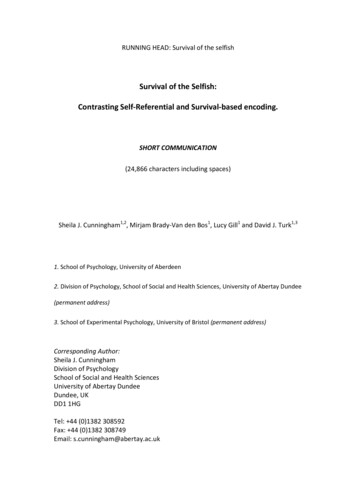




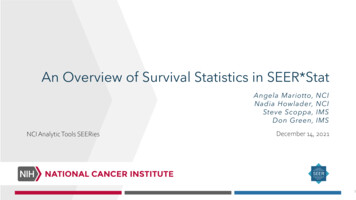
![[ST] Survival Analysis - Stata](/img/33/st.jpg)
